Types and varieties of bladderworm
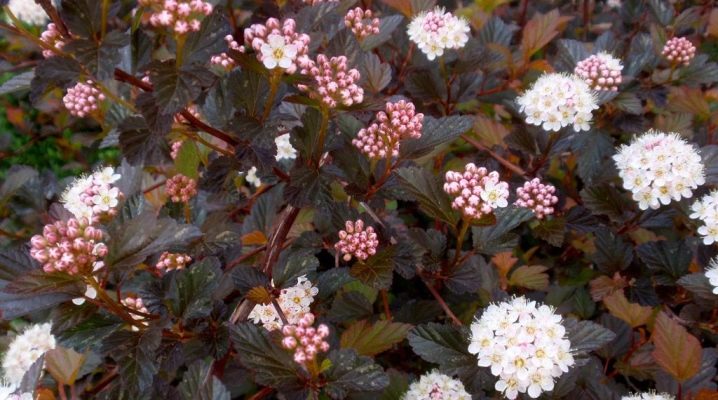
Hedges have always been one of the most popular landscape design techniques. Compositions from the viburnum bladder look especially beautiful. However, he has many equally interesting relatives - unfortunately, they are undeservedly deprived of the attention of gardeners. In our article, we will correct this injustice and introduce you to a description of the most spectacular types of vesicle.
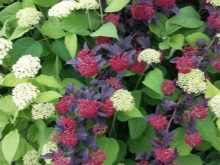
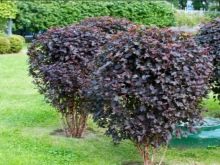
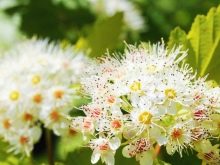
Viburnum and its varieties
To create a decorative hedge, the viburnum blister is most often used. It is a densely branched, leafy shrub that grows up to 2-3 m. Its distinctive feature is the bark, peeling off in stripes. The homeland of this plant is North America, which is why the winter hardiness of the culture is quite high - it corresponds to zones 2-8. In a cultural form, the vesicle was most widespread in the European part of Russia, up to Arkhangelsk, Perm and Kirovsk, as well as in neighboring states.
Its leaves have a rounded-oval shape with 3-5 lobes, the length varies from 7 to 10 cm.The color is saturated dark green. The flowers are small, no more than 1 cm in diameter. In the buds they have a pinkish tint, but after blooming they become snow-white. The fruits are represented by bubble-shaped leaflets. At first they have a bright red, almost scarlet color, after which they gradually acquire a brown tint. The final ripening occurs in the second half of August, September.
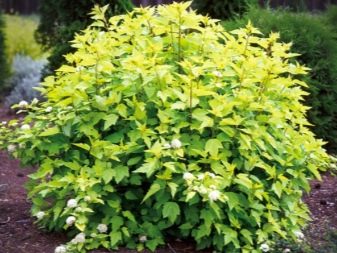

The ciliates are characterized by a high growth rate. Its neat trapezoidal or rounded crown always looks neat. As if the leaves cut out of corrugated paper keep their shape in any weather conditions, without losing their saturation of shades, until the arrival of frost.
Bubble flowering begins in the middle of summer, when many crops in the gardens have already faded. Bulky, semi-airy fruits look no less decorative.
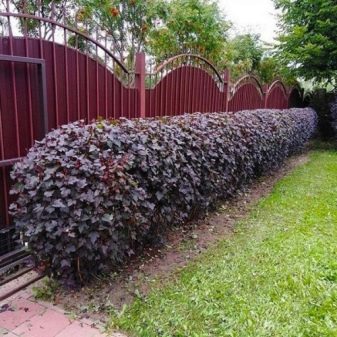
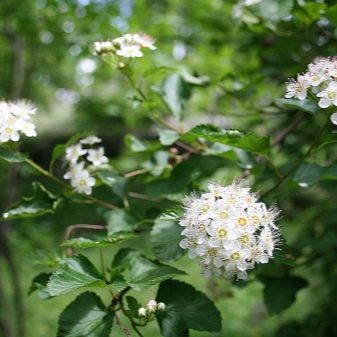
The most widespread are the following varieties of the Viburnum bladderwort.
Diablo Is an adult plant, reaching 1.5 m in width and 2 m in height. Shoots are dark red. Young foliage has a honey-copper hue, more mature leaves change color to a red-burgundy one. Snow-white flowers are collected in hemispherical inflorescences. Flowering begins in mid-summer and lasts for 4-5 weeks. The fruits are bright red.
For all its decorativeness, this vesicle is rather unpretentious. It is undemanding to the quality and composition of the soil, it is resistant to frost. The shrub gives a rather high annual growth, it is distinguished by intensive shoot formation. Thanks to this, in a couple of seasons, you can completely form a decorative hedge, or solve the problem of landscaping problem areas.
However, it must be borne in mind that this variety requires bright lighting. In conditions of shading, the leaves lose their decorative color, and the shoots turn green.
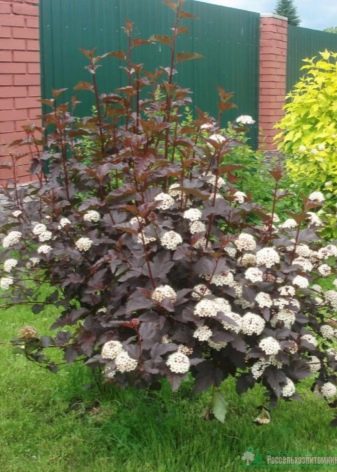
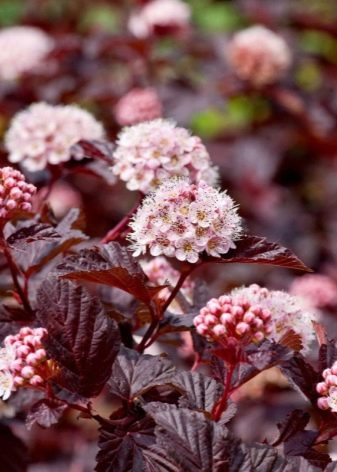
Red baron - the height of this bush is up to 2 m, the plant occupies an area with a diameter of 1.5 m. The leaves are three-lobed, the veins are clearly visible. Young ones are colored orange with a copper tint, while older ones are distinguished by a thick red tone. The flowers are white, with a slight pink tinge, flowering begins in late June, first half of July.
This variety has become widespread in the design of hedges and is recommended for trellises.
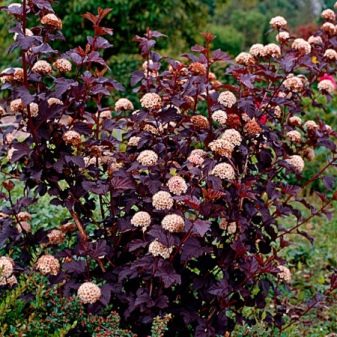
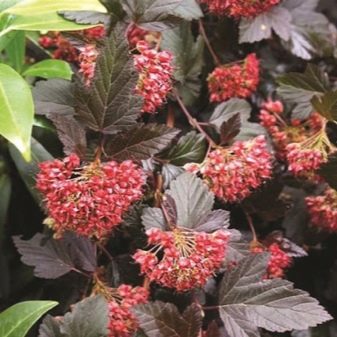
Summer wine seward - the main shoots of this bush are straight, reaching 2 m both in width and in height. The leaf plates are three-bladed, wavy. They have a dark purple hue. The bloom is light pink, almost white. The shrub is unpretentious, can successfully grow and develop on any soil.

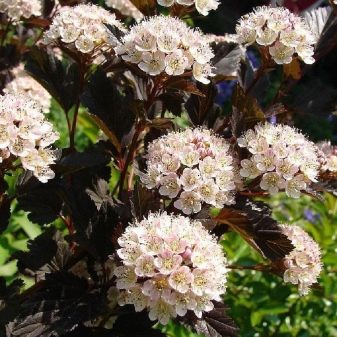
The varieties look no less decorative. yellow-leaved bladderworm.
Luteus Is a fast-growing variety up to 3 m high. Leaves can have 3-5 blades. The color is rich yellow, in the shade it acquires a light greenish tint. Flowers can be white or pale pink.

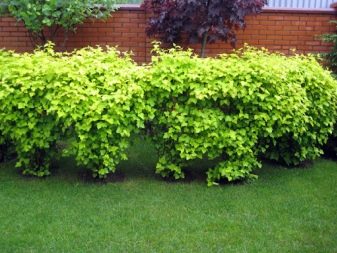
Dart s Gold - the height and width of this bush is about 1.5-2.5 m. The shoots are brown, with a pronounced pink tint, the bark flakes off in strips. The leaves are yellow-golden in color, while their shade remains throughout the growing season from spring to late autumn.
Flowering begins in mid-June and lasts about a month. During this period, snow-white flowers, abundantly strewn with branches, give a special decorative effect to the shrub. However, this vesicle needs a lot of sunlight, otherwise the leaves lose their saturation and brightness. In gardening, it is most often planted together with the Diablo shrub, thereby emphasizing the shades of both varieties.
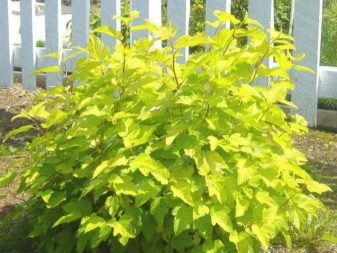
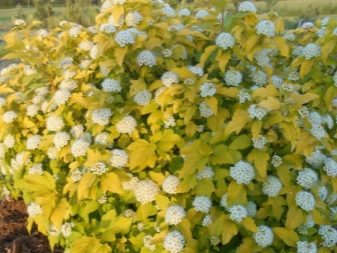
Amber jubilee Is a hybrid form derived from Darts Gold and Diablo. The name Amber Jubilee translates as "Amber Jubilee", it was given to the culture on the occasion of the 30-year stay of Elizabeth II on the English throne. It is believed that the Queen planted this unusual culture with her own hands during her visit to America in 2012.
The leaves of the shrub in the period from early spring to autumn change their shade from light yellow to deep amber, and turn purple in autumn. The variety is ideal for creating a dense hedge, as it is able to form dense, wide bushes in the shortest possible time. If you do not prune, then it easily grows up to 2 m.
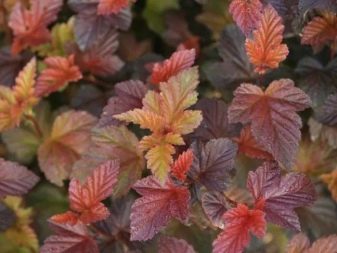
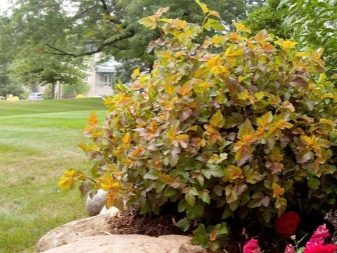
When creating a hedge, Diablo is usually combined with yellow-leaved varieties, since plantings in dark shades can seem overly gloomy. Due to their high growth rate, the bushes of the viburnum vesicle are used to create stylish plant sculptures. They look especially beautiful against the background of the lawn.
However, keep in mind - in order to form a topiary from the bladder, it will need frequent haircuts.
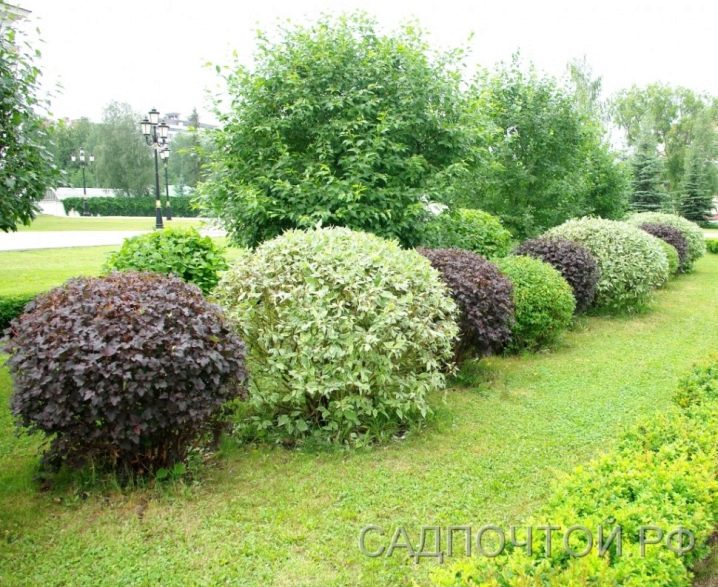
Peculiarities of the Amur bladderwort
The Amur vesicle is a little less common. But this does not mean at all that its decorative effect is lower. This culture is a shrub of a deciduous type with slightly curved branches, in favorable conditions it can grow up to 2.5-3 m.In its natural habitat it grows on the edges of deciduous forests of the Far East, as well as in the northern parts of Korea and China. Winter hardiness of plants corresponds to zones 4-8.
Shoots are red-brown, growing vertically. On them are petiolate leaves of a rather interesting rounded shape with a heart-shaped base. The length of the leaf plate reaches 80 cm. The outer surface is painted in a rich emerald color, on the reverse side the leaves are slightly pubescent and look silvery. Flowers of light pink stamens and snow-white petals are small, up to 1.5 cm in diameter. They gather in corymbose inflorescences up to 6 cm in size. Fruits are bright red, swollen.


This vesicle is distinguished by exceptional frost resistance, it can withstand temperatures down to -30 degrees.... That is why culture is widely used in urban landscaping and the arrangement of local areas. This shrub is in demand when decorating garden paths.
It looks especially harmonious in combination with marigolds and other flowering plants.

On the territory of the Far East, the vesicle is widespread currant Is a relative of the Amur vesicle. It can be found in the Amur Region, as well as in the Khabarovsk and Primorsky Territories. This shrub is distinguished by a dense spherical crown with a diameter of 1.5-2 m. The leaves are ovoid, simple in shape, with 3-5 lobes, 6-8 cm long. Snow-white flowers are collected in inflorescences of 5-25 pieces.
This type of vesicle is very hardy. It can grow even on bare rocks, fixing itself in mountain cracks. However, it reaches its best development along forest streams and in the shade of ravines. It can be seen on the slopes of limestone outcrops - it grows wherever there is limestone. In those places where there are no calcium rocks, you will not find a currant bladder.
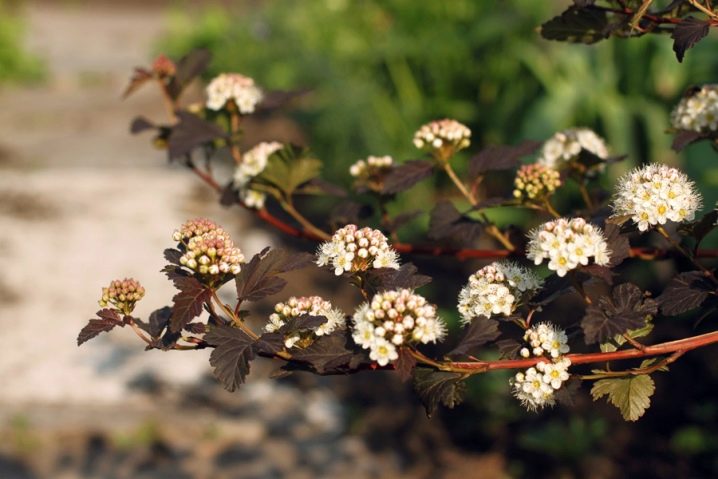
Other varieties
There are other, less well-known, but equally beautiful varieties of the bladder.
Bubble monopod - ornamental shrub 1.2 m high, up to 2 m wide. In its natural environment, it is found in North America, winter hardiness in accordance with USDA data corresponds to zone 5. Leaf plates resemble currant, but larger.
In late May - early June, white or light pink flowers bloom, over time they acquire a red-brown color, retaining this color, until the first frost. The fruits are represented by beige or green multileafs, each consisting of three leaflets that are not fused with each other. All of them contain 1-2 seeds at the base. Fruiting occurs in September.
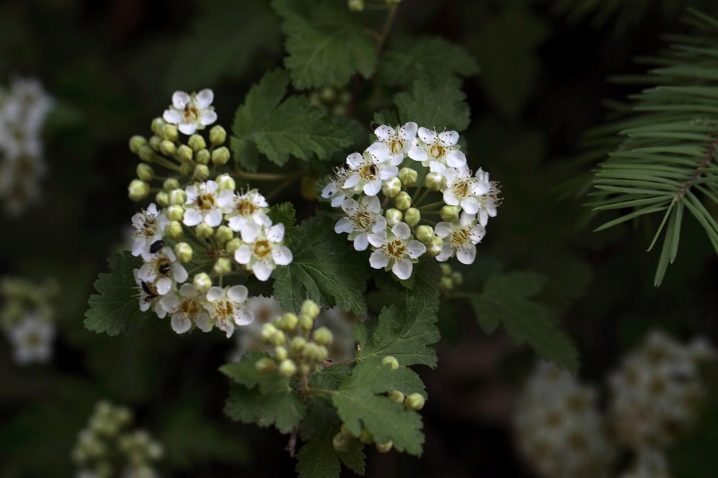
Bubbles golden yellow - a distinctive feature of this deciduous shrub is its young shoots, at a young age they are yellowish in color. The plant is leafy, grows up to 2 m. Its homeland is North America, the parameters of winter hardiness correspond to zones 3-8.
In harsh conditions, freezing of young growth cannot be ruled out.
The leaves are three-lobed, broadly ovate, 3 to 7 cm long. Flowers bloom in June-July, multi-flowered inflorescences, up to 5-6 cm in diameter. Fruits ripen in September-October.

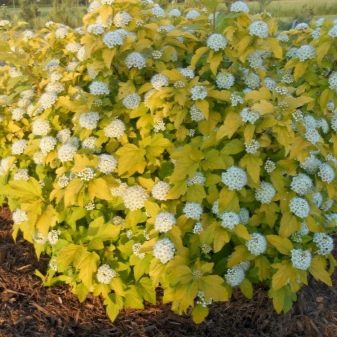
Bubble malvaceous - this shrub with a height of 1.2 m, like all the others, comes from North America. The level of winter hardiness is estimated at the level of zone 5. With prolonged frosts down to -30 degrees, shoots may freeze.
Leaves can be round and wide, ovate, 3-6 cm long. The flowers are snow-white, united in hemispherical inflorescences. Flowering begins in June and lasts about 3-4 weeks. The fruits ripen in late August - early September. In Russia, it is grown throughout the European part.
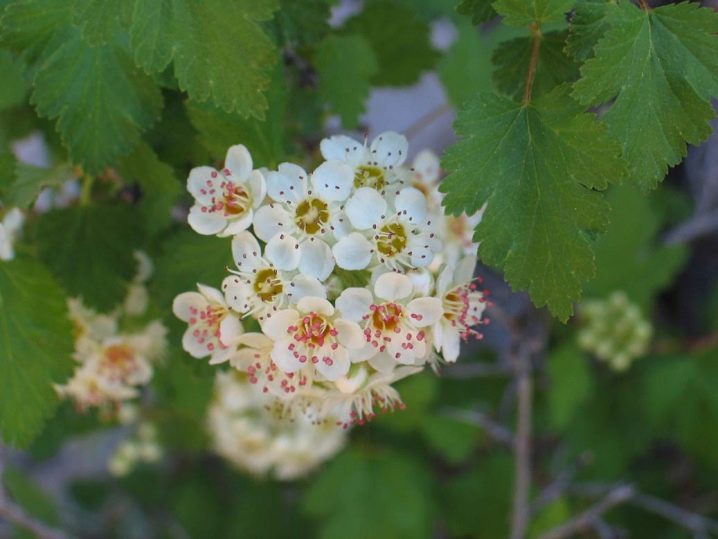
Bubble intermediate - another North American plant up to 1.5 m high. Leaves 2-6 cm long consist of three lobes, can have all shapes - from rounded to ovoid. Flowering occurs in July-August. The flowers are white, united in thyroid inflorescences. Fruit ripening occurs at the beginning of October. In our country, it successfully grows and develops throughout the European part.
Slightly less often, tall and dwarf varieties All Black, Midnight, Ennis Gold, Tiny Vine, Little Greens, Center Glow, Rubella, as well as capitate varieties Tilden Park and Little Angel are used in garden landscaping.
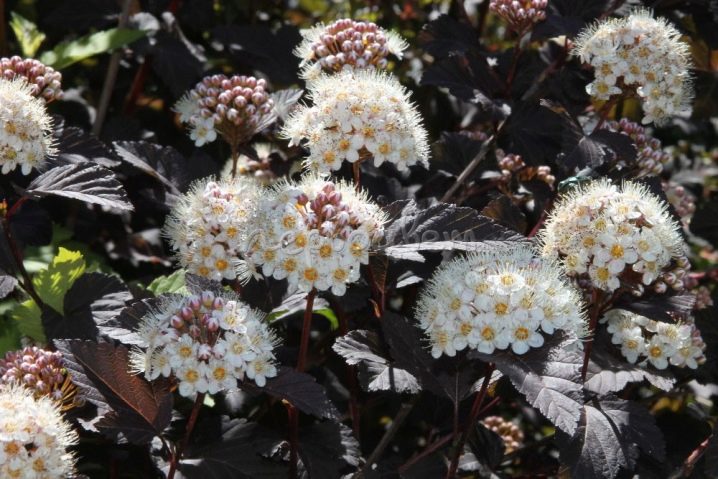































































The comment was sent successfully.